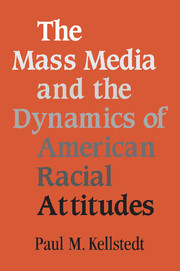Book contents
- Frontmatter
- Contents
- List of Figures
- List of Tables
- Preface
- The Mass Media and the Dynamics of American Racial Attitudes
- 1 Toward a Dynamic Perspective on Racial Attitudes
- 2 Eras of Media Coverage of Race
- 3 Eras of Racial Liberalism and Conservatism
- 4 Media Framing and the Dynamics of Racial Policy Preferences
- 5 The Fusion of Race and the Welfare State in the Public Mind
- 6 A New American Dilemma for a New Millennium?
- Appendix
- References
- Index
1 - Toward a Dynamic Perspective on Racial Attitudes
Published online by Cambridge University Press: 06 January 2010
- Frontmatter
- Contents
- List of Figures
- List of Tables
- Preface
- The Mass Media and the Dynamics of American Racial Attitudes
- 1 Toward a Dynamic Perspective on Racial Attitudes
- 2 Eras of Media Coverage of Race
- 3 Eras of Racial Liberalism and Conservatism
- 4 Media Framing and the Dynamics of Racial Policy Preferences
- 5 The Fusion of Race and the Welfare State in the Public Mind
- 6 A New American Dilemma for a New Millennium?
- Appendix
- References
- Index
Summary
On the question of the social integration of the races our people draw the line. No decent and self-respecting Negro would ask for a law to force people to accept him where he is not wanted. They themselves do not want social intermingling. They are entitled to equality of opportunity, and they will get it through our efforts. But all the laws of Washington and all the bayonets of the army cannot force the Negro into our homes, our schools, our churches, and our places of recreation.
– Governor J. Strom Thurmond, D-SC, 1948 (quoted in Cohodas, 1993)When I was governor, the laws said the races should be separated. But now the law is different, customs are different, public opinion has changed, and it's an entirely different situation.
– Senator J. Strom Thurmond, R-SC, 1978 (quoted in Cohodas, 1993)The year is 1950. The place, the post–World War II South. Southern society is completely divided along racial lines. In fact, the notion that a single “southern society” even exists strains credibility. Instead, there are two southern societies – one white and one black. Black children and white children do not attend the same schools. Blacks and whites do not drink from the same water fountains or eat at the same restaurants. They do not buy groceries at the same stores. They do not participate in social or recreational activities together. Only a few short years before, they did not even fight in the same units in the armed forces.
- Type
- Chapter
- Information
- Publisher: Cambridge University PressPrint publication year: 2003



